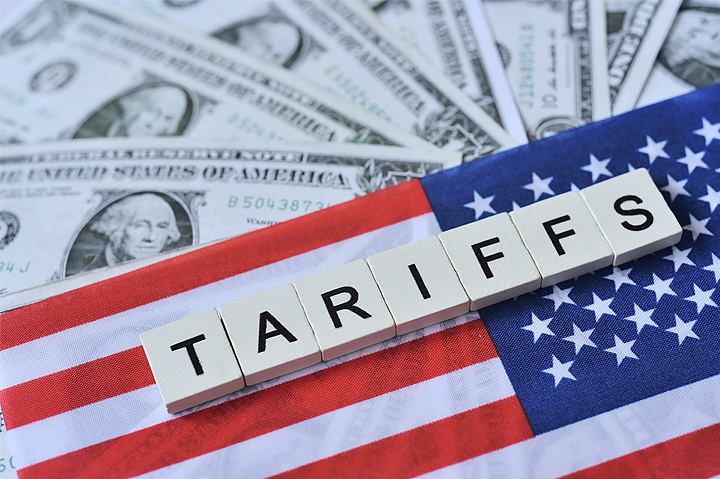
“I’ve never seen language like this on a survey,” Andy Paparozzi, chief economist at PRINTING United Alliance, says.
The survey Paparozzi points to is the most recent State of the Industry Report, “Turning Uncertainty into Opportunity,” produced by Alliance Insights and sponsored by Canon U.S.A. The report features results from the State of the Industry Panel, which consists of more than 300 companies in the printing industry who regularly participate in Alliance surveys, with this one in particular focusing on the uncertainty created by recent tariff policies. Paparozzi explains that a deep passion regarding this topic — both for and against the tariffs — resulted in the “colorful language” used in some of the responses. With a topic eliciting such passion, it’s reasonable to question if the results could be unbiased, one way or the other. Paparozzi says yes.
“Approximately 35% of the participants in our survey say, over the long term, these tariffs are the right thing to do. They balance the playing field,” he says. “To quote one of them, ‘They make it easier and fairer for us to compete with offshore providers. And over the long term, they will revitalize American manufacturing.’”
And while 35% believe tariffs will have long-term benefits, the numbers show that the road ahead will be challenging. One of the most compelling statistics from the survey, Paparozzi notes, is that “27% of the industry panel report they have increased pre-tax profitability this year, while four times as many — 73% — report profitability has decreased, or at best, been flat. So, whatever long-term benefits the [tariffs] have, whether they’re right or wrong … they have hit the industry very hard.”
Harsh Reality
While some PSPs see the tariffs as a positive for the industry, some challenges and concerns cannot go unstated.
One of the most significant effects Marco Boer, vice president of I.T. Strategies, notes is the impact of unbudgeted tariffs, which could be potentially devastating.
“For example, we have a friend who bought a $6 million offset press and they were hit with a $1.2 million charge in tariffs,” he says. “This is leading a lot of commercial printers to delay because the irrational fear in life is that if they wait and the tariff drops from 20% to 10%, then they’ve just wasted $600,000 that they didn’t need to waste.”
Paparozzi also points to this as a concern, noting that it’s natural to want to delay investments when there is uncertainty, but this puts a company at risk of falling behind.
“One of the most troubling statistics we have in this report is that 59.1% are delaying or may delay capital investment because of the uncertainty,” he says. However, he emphasizes that that poses a risk. “When the turning point comes and things start moving up again, you can’t participate, you can’t catch up.”
According to the State of the Industry panelists that participated in the survey, the No. 1 concern heading into the second half of 2025 is the possibility of a sharp slowdown in the economy or a recession caused by the uncertainty created by the “erratic tariff policy,” Paparozzi notes. The second is the uncertainty that the tariff policies are creating and the effects on operating costs and profitability.
“Right now, there’s no question that they have hit the industry hard and created a classic textbook profit squeeze,” he says.
Infrastructure is another challenge. While it’s a positive if tariffs bring manufacturing back to the United States, it will be difficult to ensure the necessary resources are in place.
“We don’t have the ecosystems in place here in the U.S. to do manufacturing,” Boer notes. “You could assemble things, but you’re not going to be able to buy the widgets that go into the product because they’re just no longer made in the U.S., and they won’t be. It would take a decade to establish.”
Beyond that, there are also issues of power, people, and places.
“Our electricity grid can barely support the economy as it is,” Paparozzi points out. “Never mind when we’re talking about AI [artificial intelligence] in the data centers. We’re going to have to dramatically increase our electricity grid. And [there’s also] labor supply. Where are we going to get people to staff additional manufacturing facilities? That’s where we got into the whole issue of smart robotics. In terms of restructuring supply chains, dramatically upgrading the electricity grid, and through investments in robotics or very strong trade school programs, we have to have the personnel necessary to support additional manufacturing.”
The impact could be severe for some segments, especially those dependent on imported consumables, Boer says.
“I think this is going to accelerate the decline of low-value stuff,” he says. “You might see compliance statements disappear overnight. And that’s the risk in our industry. It’s no longer projectable. It’s not a nice, gradual decline; you’re gonna have cliffs, where things disappear overnight. The tariffs will accelerate that.”
Read this full article on Printing Impressions, a publication of PRINTING United Alliance, ASI’s strategic partner.



